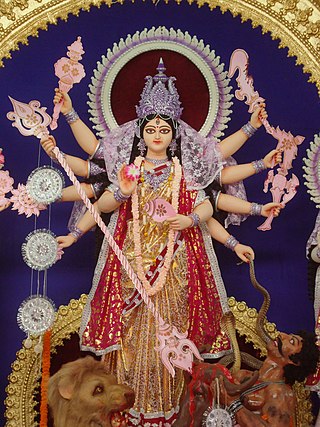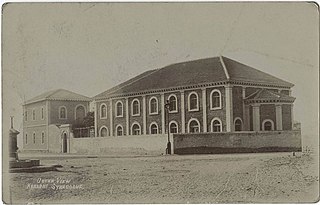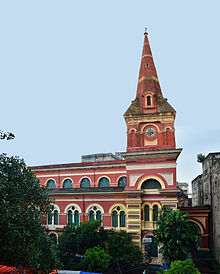
A synagogue, also called a shul or a temple, is a place of worship for Jews and Samaritans. It has a place for prayer where Jews attend religious services or special ceremonies such as weddings, bar and bat mitzvahs, choir performances, and children's plays. They also have rooms for study, social halls, administrative and charitable offices, classrooms for religious and Hebrew studies, and many places to sit and congregate. They often display commemorative, historic, or modern artwork alongside items of Jewish historical significance or history about the synagogue itself.

Synagogue architecture often follows styles in vogue at the place and time of construction. There is no set blueprint for synagogues and the architectural shapes and interior designs of synagogues vary greatly. According to tradition, the Shekhinah or divine presence can be found wherever there is a minyan, a quorum, of ten. A synagogue always contains a Torah ark where the Torah scrolls are kept, called the aron qodesh by Ashkenazi Jews and the hekhal by Sephardic Jews.

Baghdadi Jews or Iraqi Jews are historic terms for the former communities of Jewish migrants and their descendants from Baghdad and elsewhere in the Middle East. They settled primarily in the ports and along the trade routes around the Indian Ocean and the South China Sea.

Kolkata, India, is largely inhabited by the ethnic community of the native Bengalis respectively. According to a report by the Indian Statistical Institute owned by the Government of India, the Kolkata city had a population of 4.5 million as of 2011 out of which the population of native Bengalis in Kolkata is almost 62% which comprised the majority of the city's population, whereas ethnic groups like Marwaris, Biharis and Urdu-speaking Muslims together forming 36% of the population which comes under the category of large minorities. Other Various micro-minority communities of Kolkata include as far as concerned follows -: Pathans, Marathis, Odias, Gujaratis, Sindhis, Kashmiris, Punjabis, Nepalis, Telugus, Tamils, Anglo-Indians, Iraqis, Jews, Armenians, Tibetans, Greeks, Parsis, Chinese, and Iraqis etc.

The Knesset Eliyahoo Synagogue, also Knesset Eliyahu and the Blue Synagogue, is an Orthodox Jewish congregation and synagogue, located at 55, Dr. V.B. Gandhi Marg, in the Kala Ghoda neighborhood, Fort, in downtown Mumbai, in the state of Maharashtra, India. Completed in 1884, it is the second oldest Sephardic synagogue in Mumbai. The Taj Mahal Palace Hotel, and Oberoi Trident are nearby.

The Magen Abraham Synagogue is an Orthodox Jewish congregation and synagogue, located in the Old Town neighbourhood of Ahmedabad, in the state of Gujarat, India. As of 2015, it was the only synagogue in the entire state. It was built in 1934 using donations from members of the Bene Israel Jewish community of the state.

There are many synagogues in the Indian subcontinent, although many no longer function as such and today vary in their levels of preservation. These buildings dating from the mid-sixteenth through the mid-20th century once served the country's three distinct Jewish groups—the ancient Cochin Jews, and Bene Israel communities as well as the more recent Baghdadi Jews.

The Magain Shalome Synagogue was a former Orthodox Jewish congregation and synagogue, that was located in Karachi, Pakistan.

The Chachmei Lublin Yeshiva Synagogue is a Hasidic Jewish congregation, synagogue, and yeshiva, located at 85 Lubartowska Street, in Lublin, in the Lublin Voivodeship of Poland.

Congregation Beth Ahabah is a Reform Jewish synagogue at 1121 West Franklin Street, Richmond, Virginia, in the United States. Founded in 1789 by Spanish and Portuguese Jews as Kahal Kadosh Beth Shalome, it is one of the oldest synagogues in the United States.

The Magen David Synagogue is an Orthodox Jewish congregation and synagogue, located in Byculla, Mumbai, in the state of Maharashtra, India.

The history of the Jews in Kolkata, formerly known as Calcutta, in India, began in the late eighteenth century when adventurous Baghdadi Jewish merchants originally from Aleppo and Baghdad chose to establish themselves permanently in the emerging capital of the British Raj. The community they founded became the hub of the Judeo-Arabic-speaking Baghdadi Jewish trading diaspora in Asia.

The Or Zaruaa Synagogue is an Orthodox Jewish congregation and synagogue, located at 3 Shmuel Refaeli Street, in the Nachlaot Ahim neighbourhood of Jerusalem, Israel. The congregation was founded in 1926 by Rabbi Amram Aburbeh for Maghrebi Jews from North Africa.

Kahal Kadosh Beth Shalome is a former Jewish congregation and synagogue that was located in Richmond, Virginia, in the United States. Established in 1789, the congregation merged with Congregation Beth Ahabah in 1898.

David Joseph Ezra was a leading merchant, property developer and communal leader of the Baghdadi Jewish community in Kolkata, India. He was one of the key developers behind nineteenth century Kolkata, and was responsible for many of its most celebrated Victorian buildings and synagogues.

Elias David Joseph Ezra was a property owner in Calcutta, India. He was a member of the Baghdadi Jewish community of that city.
Ezekiel Judah also known as Yehezkel Yehuda, or Yahuda, or Ezekiel Judah Jacob Sliman, was a Jewish communal leader, trader of indigo, muslin, and silk, philanthropist, and Talmudist from Baghdad. He migrated to India, where he led the Baghdadi Jewish community of Kolkata and established the city's first synagogues.

Nahoum & Sons Pvt. Limited is an Indian bakery shop situated in West Bengal. It is one of the oldest surviving shops in Kolkata owned by the Jewish family. The products of Nahoum & Sons at Christmas are a part of the culture of Kolkata. Various famous personalities of India have eaten from this bakery.
Shalom Aaron Obadiah Cohen (1762-1836) was a Jewish jeweler, merchant and community leader known for founding the Jewish community in Calcutta (Kolkata) in 1798.






















